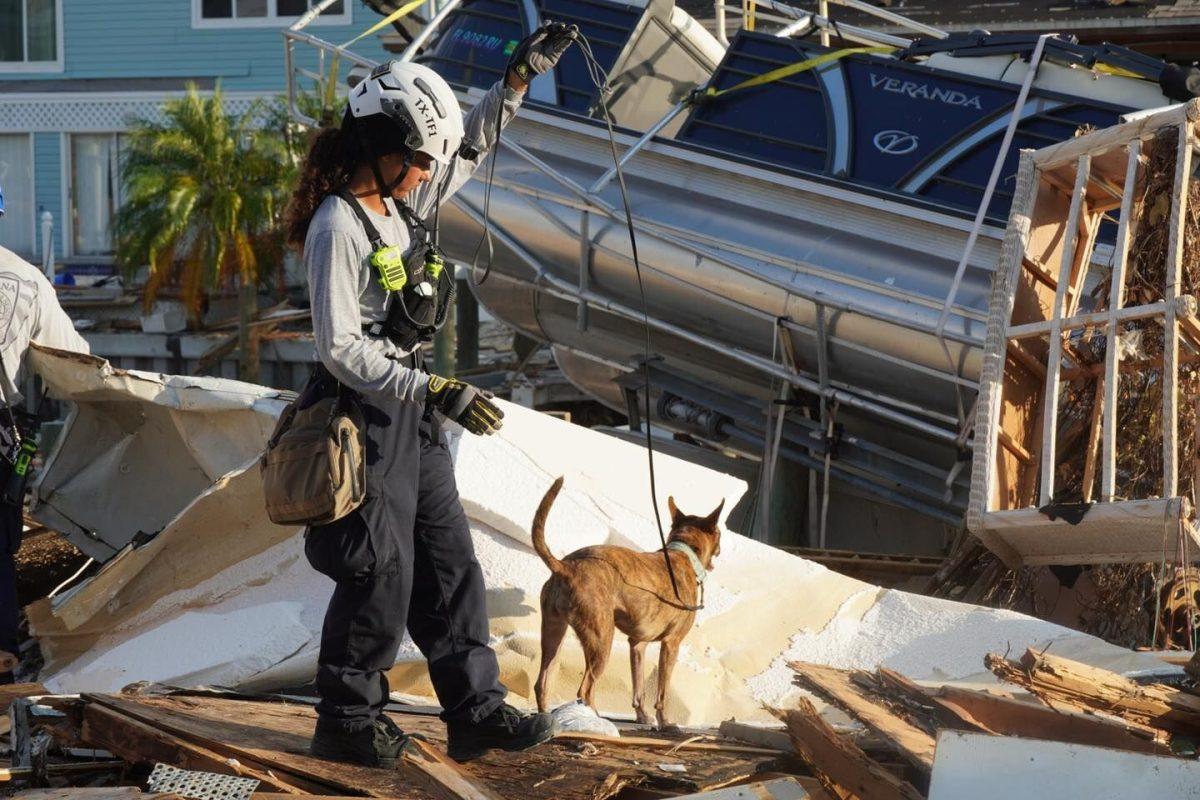As Hurricane Ian is the deadliest hurricane to hit Florida since 1935, students and staff traveled to aid in recovery efforts.
Texas Gov. Greg Abbott deployed the Texas A&M Veterinary Emergency Team, or VET, AgriLife Extension Service’s Disaster Assessment and Recovery Unit, Forest Service and Engineering Extension Service Task Force 1. The state of Florida deployed the Texas A&M Center for Robot-Assisted Search and Rescue, or CRASAR.
Task Force 1, deployed by Abbott, brought 45 personnel to assist in search and rescue.
“The spirit of Texas is helping one another in times of need, and we are proud to help our fellow Americans in Florida ahead of the arrival of Hurricane Ian,” Abbott said in a statement. “Texas is no stranger to hurricane disaster response efforts, and we recognize the urgency for additional resources in preparation of this Category 3 storm. We greatly appreciate the generosity of Floridians and aid the State of Florida has sent us during times of crisis in our state — and we are honored to do the same.”
VET brought 20 personnel to Florida on Tuesday, Oct. 4, through Wednesday, Oct. 12. The team included veterinarians, technicians and staff as well as disaster assessment recovery agents from the Texas A&M AgriLife Extension Service. VET has aided in over 35 disasters including Hurricane Harvey, wildfires and most Texas disasters.
VET provided veterinary medical support to dogs that were part of the urban search and rescue, or USAR, groups. Associate Professor and VET Director Wesley Bissett said this included treating wounds and focusing on hydration in the hot climate.
“They have a very challenging job, and we take care of their health, making sure that all the preventive steps that can be taken to keep them healthy are being taken,” Bissett said. “Based on the environment they’re working in, they get abrasions, basically wear and tear type lesions on their feet and legs. We manage them as minor wounds. The other part is if one of our canine team members gets seriously injured, we’re there to provide that veterinary medical support as well.”
VET worked with around 25 canines every day. They were based with Texas and Ohio Task Force One in a parking lot, and would send medical units out to the canines at places like Fort Myers Beach.
In addition, VET also offers a special decontamination unit when dogs get contaminated by flood waters.
“A number of years ago, we built a [decontamination] unit that allows us to put dogs inside a unit that is completely contained,” Bissett said. “It has filtered air going in and filtered air coming out so the dogs are comfortable. We can decontaminate those dogs with soap and water, then get them clean. It’s safe for the dogs and safe for us.”
The request for VET deployment came from the Federal Emergency Management Agency based on the number of USAR dogs, and made its way up to Abbott who approved it.
On the other hand, the state of Florida deployed CRASAR. Professor and CRASAR Director Robin Murphy traveled to Florida Monday, Oct. 3, with Ph.D. student Thomas Manzini. While they brought drones, they didn’t fly them, and instead provided data management.
“We’ve been pioneering [this] data to decision processes since 2015,” Murphy said. “We came up with some new methods in 2017 for Hurricane Harvey, which at that time was the largest use of drones. We’ve been teaching this with Florida State University, our partners, and we taught at the National Hurricane conference back in April. We got to put some of our updated procedures into play [with Hurricane Ian recovery efforts].”
Murphy and Manzini worked with other recovery teams in Florida. Collectively from all teams, drones brought in over 47,000 files of data in the first four days.
“The main thing was that we collected the data that all the different teams in the field were collecting from their different vehicles,” Manzini said. “The team goes out, and they generate a video or a map or a bunch of photos. They bring the data back to us. We aggregate it, store it, label it, and then pass that sort of correlated information up the chain of command.”
The data primarily came in the form of images and videos.
“A lot of times you’re stitching those images together very quickly creating a map,” Murphy said. “Then, you can see what roads are closed, what bridges are down, which houses are hit, and more importantly, how to get resources to those people.”
Murphy and Manzini helped with sorting and distributing these files.
“There’s at least 20 agencies all trying to look for something in that imagery, but everything slightly different that they care about, some of them need it sooner than other agencies,” Murphy said. “So how do you get the right information to the right person at the right time and in the right format, so that they’ll be able to make the right decision?”
CRASAR has assisted with over 30 disasters including Hurricane Katrina in 2005 and Hurricane Harvey in 2017. Murphy says that they never self-deploy, they always are requested by authority with Incident Command Authority.
“The big thing with a mission is getting the right data, the right people,” Murphy said. “We all fly [drones]. We process. It’s a team sport. The main thing is we’re to save lives and to accelerate that economic recovery, get everybody back on their feet.”
Manzini is working on his Ph.D. in machine learning and artificial intelligence for disaster and emergency, and will graduate in 2026. This is the largest disaster Manzini has ever responded to, but he has worked as an EMT and firefighter for years.
“Field work has always been a passion of mine, and being able to do that in such a large scale, was really rewarding,” Manzini said. “The thing that really stuck out to me the most was the criticality of data resources and bandwidth. For example, we had very slow internet out there. It’s just faster to put a person in a car with a USB drive or an external hard disk and drive them somewhere to upload it, and the amount of delay that generates is something that I was very surprised about.”
Manzini studies under Murphy, so when Murphy was deployed to represent CRASAR, she brought Manzini with her.
“Even though A&M is a top school working in disasters, there are very few people who do this in the world,” Murphy said. “It’s that everybody, students and administrators, are all together behind it 110%. I know it makes a difference to our community.”









